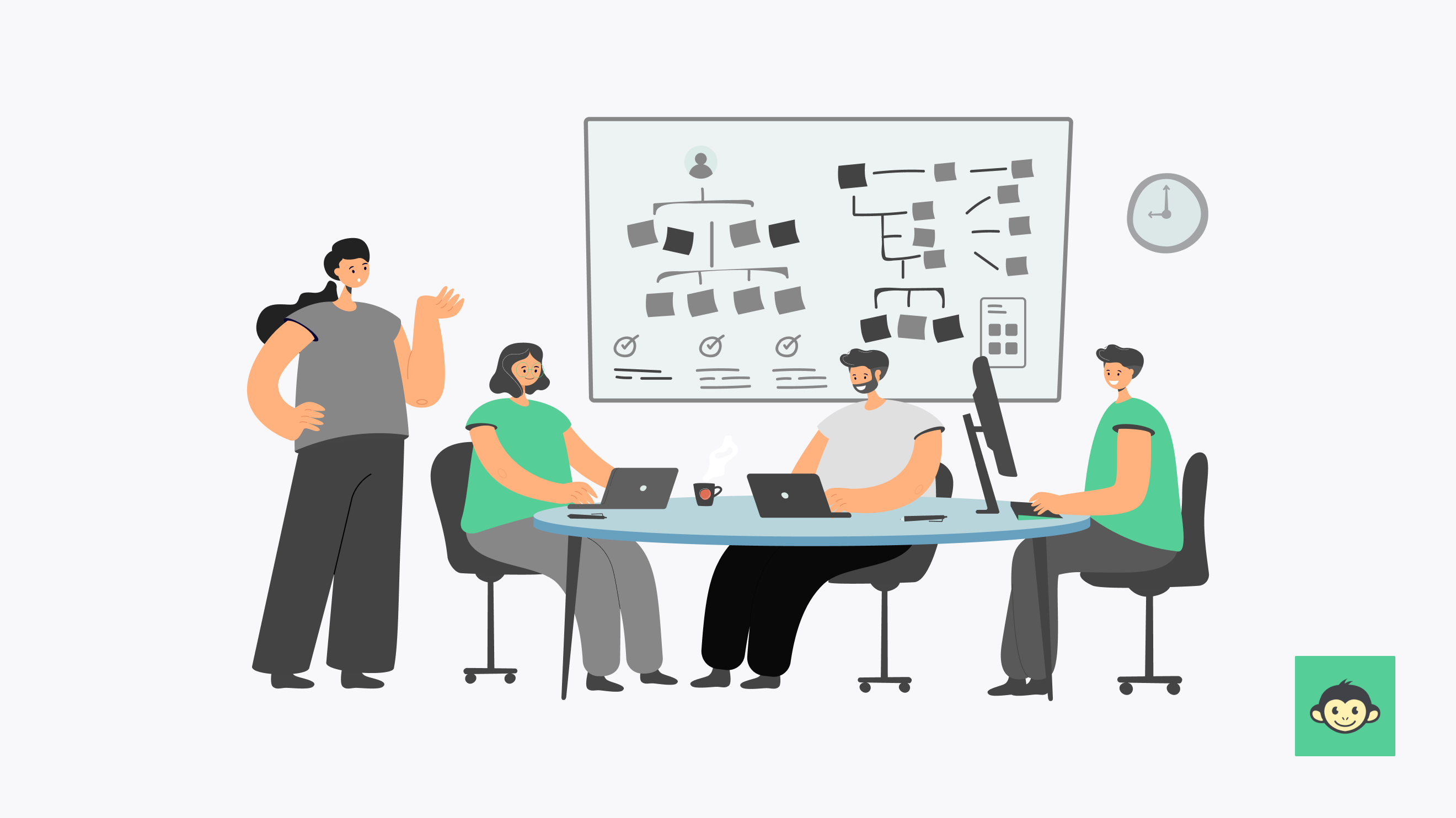15 Employee engagement strategies for small businesses at their earliest stages

Making sure your team is happy and involved isn't just a bonus; the special ingredient turns a group of people into a super-effective and creative bunch.
In this blog, let’s discuss the top 15 ways to excite your team, especially if your business is at an earlier stage.
No need for fancy words – we're talking about real, practical stuff that can make your workplace a fantastic and thriving space. So, get ready to sprinkle some magic on your workplace.
Let's jump into the world of making your small business a place where everyone works and enjoys it.
Let’s begin.
What is employee engagement for small businesses?

Employee engagement for small businesses is like the heartbeat of a thriving workplace. It measures how connected, motivated, and invested your team members are in their work. Simply put, it's about ensuring everyone on your small business team feels valued, happy, and excited to contribute.
It goes beyond just completing tasks – it's about creating an environment where people genuinely want to give their best, share ideas, and feel like they're an essential part of the business journey.
Whether you're a team of five or fifty, fostering employee engagement with just a few strategies is the secret sauce that turns a group of individuals into a tight-knit, high-performing team.
How to engage employees as a small business owner?

Engaging your employees is the secret sauce, and in this guide, we've got practical strategies tailored just for you. From recognizing efforts to building a positive culture, here's how you, as a small business owner, can spark the flame of engagement and turn your workplace into a hub of enthusiasm.
Recognize and appreciate
Start by acknowledging your team's efforts. A simple "thank you" or a shout-out for a job well done can go a long way. When employees feel their hard work is noticed and appreciated, it boosts morale and creates a positive work atmosphere.
Open communication channels
Foster an environment where communication flows both ways. Encourage team members to share their thoughts, ideas, and concerns. This not only makes employees feel heard but also creates a culture of transparency, which is vital for engagement.
Provide growth opportunities
Even in a small business, show your team that there's room for growth. Whether it's through skill-building workshops, additional responsibilities, or promotions, employees should see a clear path for advancement within the company.
Flexibility in work arrangements
Offer flexibility in work schedules or remote work options when possible. Small gestures like understanding personal commitments or allowing a flexible start time contribute significantly to a positive work-life balance.
Build personal connections
As a small business owner, take the time to know your team members personally. Understand their interests, celebrate birthdays, and create a sense of camaraderie. A close-knit team often translates into higher job satisfaction and boost employee engagement too.
Employee recognition programs
Implement a formal recognition program. This could be a monthly award for outstanding performance, a peer-to-peer recognition system, or a small incentive program. Recognizing achievements fosters a sense of accomplishment and motivates employees.
Encourage skill development
Support continuous learning by providing access to training programs or workshops. This not only enhances skills but also shows your commitment to your employees' professional development, making them feel invested in and valued by the company.
Emphasize work-life balance
Acknowledge the importance of a healthy work-life balance. Encourage employees to take breaks, use their vacation days, and disconnect after work hours. This not only prevents burnout but also signals that you prioritize their well-being.
Regular feedback and check-ins
Establish a culture of regular feedback. Schedule one-on-one check-ins to discuss goals, progress, and any challenges. This ensures that employees feel supported, know where they stand, and have a platform to voice their concerns.
Involve employees in decision-making
Where possible, involve employees in decision-making processes. Seeking their input on matters that affect their work gives them a sense of ownership and inclusion, fostering a more engaged and motivated team.
Social events and team-building
Organize social events or team-building activities. These can be as simple as a casual friday lunch or a more structured team-building day. Creating opportunities for employees to bond outside of work contributes to a positive and cohesive team dynamic.
Prioritize well-being
Show that you care about your employees' well-being. This could involve providing wellness programs, mental health resources, or creating a comfortable workspace. A healthy and supported team is more likely to be engaged and productive.
Transparent goal setting
Be transparent about the company's goals and how each employee contributes to them. When individuals understand their impact on the bigger picture, it creates a sense of purpose and motivation to work towards common objectives.
Lead by example
As a small business owner, lead by example. Demonstrate the work ethic and attitude you expect from your team. Your enthusiasm and commitment will inspire others and contribute to a positive and engaged work environment.
Foster a positive work culture
Lastly, cultivate a positive work culture where collaboration, respect, and enthusiasm are the norm. When employees enjoy the environment they work in, they're more likely to be engaged and eager to contribute to the success of the business.
So, small business warriors, gear up to witness the transformative power of these engagement strategies – your key to not just running a business, but fostering a community of dedicated contributors. Let the journey to a thriving workplace commence!
What is an engagement strategy for a small business?

An engagement strategy is a compass that guides your team towards a collaborative and motivated workplace. It involves a thoughtful approach to connect, inspire, and retain employees, fostering a sense of belonging and commitment.
Unlike one-size-fits-all solutions, a tailored strategy for a small business acknowledges its unique culture and challenges, aiming to amplify team cohesion and productivity.
Developing such a strategy requires a multi-faceted approach. As mentioned above, you could start by recognizing and appreciating individual contributions – a personalized "thank you" can create ripples of motivation. Open communication channels, where team members feel heard and valued, form the bedrock of best employee engagement strategies.
Beyond verbal recognition, invest in tangible growth opportunities that demonstrate a commitment to your employees' professional development within the organization.
Flexibility in work arrangements is another key pillar. Acknowledge the importance of a healthy work-life balance, offering options like flexible schedules or remote work when feasible. Incorporate regular feedback mechanisms to ensure continuous improvement and allow employees to express their opinions and concerns.
In small businesses, where each team member plays a crucial role, team-building activities can be transformative. Whether it's a simple lunch gathering or a more structured event, fostering personal connections among team members can enhance collaboration and improve employee engagement.
Combine this with a transparent goal-setting approach, aligning individual contributions with overarching company objectives creating a sense of purpose.
Embrace the role of a leader by setting an example. Your enthusiasm and commitment will inspire your team to reciprocate, creating a positive work culture. Prioritize the well-being of your current and future employees, providing wellness programs and resources to ensure a healthy and supportive work environment.
An engagement strategy for a small business is a dynamic roadmap, weaving together appreciation, communication, growth, flexibility, and a positive work culture. Tailored to the unique characteristics of a small team, it transforms a group of individuals into an engaged, high-performing collective – the cornerstone of a successful small business journey.
Common employee engagement challenges faced by small businesses owners

Small business owners, while the entrepreneurial journey is thrilling, it isn't without its fair share of challenges, especially when it comes to engaging your valuable team. Let's spotlight some common hurdles you might encounter on this engagement adventure:
Limited resources
- Challenge: Small businesses often operate on tight budgets, making it challenging to invest extensively in employee engagement initiatives.
- Solution: Creativity is your ally here. Look for cost-effective ways to show appreciation, such as personalized shout-outs or recognition in team meetings. Remember, it's the thoughtful gestures that count.
Lack of formal HR structure
- Challenge: With a smaller team, the absence of a dedicated HR department can make implementing formal engagement programs seem daunting.
- Solution: Embrace simplicity. Informal recognition and open communication channels can bridge this gap. Encourage team members to share feedback directly, fostering a culture of transparency.
Limited growth opportunities
- Challenge: Small teams may have fewer hierarchical levels, leading to perceived limitations in career growth within the company.
- Solution: Emphasize the potential for skill development. Provide access to workshops, online courses, or mentorship programs. Even in a small setting, showcase the paths for professional advancement.
Work-life balance struggles
- Challenge: The intensity of small business operations might lead to challenges in maintaining a healthy work-life balance for both you and your team.
- Solution: Advocate for balance. Encourage breaks, reasonable working hours, and lead by example. A well-balanced team is more likely to stay engaged and avoid burnout.
Limited time for formal training
- Challenge: Small businesses often operate in a fast-paced environment, leaving little time for formal training sessions.
- Solution: Opt for bite-sized learning opportunities. Implement on-the-job training or microlearning modules that align with your team's workflow, ensuring continuous development without disrupting daily operations.
Team member burnout
- Challenge: Small teams mean everyone plays a critical role, making the risk of burnout higher, especially during busy periods.
- Solution: Prioritize well-being. Encourage breaks, offer support, and be attentive to signs of burnout. Sometimes, a small acknowledgment of hard work can go a long way in revitalizing an exhausted team member.
Lack of formalized feedback mechanisms
- Challenge: In the absence of formal HR structures, obtaining regular feedback might prove challenging, hindering opportunities for improvement.
- Solution: Create informal channels. Schedule regular check-ins, use anonymous suggestion boxes, or implement quick pulse surveys. These methods provide insights without overwhelming your small team.
In small businesses, overcoming employee engagement challenges requires a blend of resourcefulness, adaptability, and a genuine commitment to creating a workplace where everyone feels valued and motivated.
Remember, addressing these challenges head-on can lead to a more engaged and resilient team, propelling your small business to greater heights.
What should an engagement strategy include?

Crafting an effective engagement strategy demands a holistic approach tailored to your unique workplace. Here's a breakdown of key components to ensure your strategy hits all the right notes:
Team-building and social activities
- Why: Building personal connections enhances teamwork and morale.
- How: Organize team-building activities, social events, or even simple friday lunches. These activities create bonds beyond work tasks, fostering a sense of camaraderie.
Employee wellness programs
- Why: Prioritizing well-being contributes to a healthy and engaged workforce.
- How: Implement wellness initiatives such as fitness challenges, mental health resources, or health-related workshops. A focus on employee well-being supports a positive work culture.
Leadership visibility and approachability
- Why: Approachable leaders create an inclusive and supportive workplace.
- How: Encourage leaders to be visible, engage in regular conversations, and lead by example. A leadership team that is present and approachable fosters trust and a positive emotional connection.
Employee surveys for continuous improvement
- Why: Regular feedback ensures your strategy evolves with your team's needs.
- How: Conduct periodic surveys to gather insights on engagement levels and areas for improvement. Use this feedback to refine and enhance your engagement strategy.
Inclusive social responsibility initiatives
- Why: Engaging in social responsibility creates a sense of purpose for your team.
- How: Integrate socially responsible initiatives, such as community outreach or environmentally friendly practices. Involving your team in meaningful causes fosters a shared sense of responsibility. Building an inclusive space is important.
Positive physical workspace
- Why: A well-designed workspace positively influences productivity and engagement.
- How: Invest in comfortable furniture, vibrant colors, and a layout that encourages collaboration. A visually appealing and functional workspace contributes to a positive work environment.
Clear company goals and expectations
- Why: Aligning individual efforts with company goals creates a sense of purpose.
- How: Communicate the company's core values and goals clearly and connect them to individual roles. When employees see the impact of their work on the broader picture, it enhances their sense of purpose and engagement.
A successful engagement strategy weaves these elements together, creating a tapestry of connection, growth, and appreciation. Tailor these components to fit your small business's unique culture, and watch as your team transforms into a motivated and engaged force propelling your business forward.
Why should small businesses should focus on employee engagement strategies?

Small businesses stand to gain substantial benefits by prioritizing effective employee engagement strategies. Here's why fostering a culture of engagement should be at the forefront of your business priorities:
Enhanced productivity and efficiency
Engaged employees are inherently more productive. When individuals feel connected to their work and workplace, they invest extra effort, resulting in increased efficiency. This heightened productivity directly contributes to achieving business goals with limited human resources alone.
Improved employee retention
Employee turnover can be a significant challenge for small businesses. Engaging your team by recognizing their contributions and providing growth opportunities creates a sense of loyalty. This, in turn, reduces turnover rates, saving your business both time and resources associated with recruitment and training.
Heightened innovation and creativity
An engaged workforce is a creative workforce. When employees feel valued and encouraged to share ideas, they become more innovative. This creative synergy can be a game-changer for small businesses, fostering adaptability and inventive solutions to challenges.
Positive company culture
Small businesses thrive on a positive company culture. Employee engagement strategies contribute to creating a workplace where individuals enjoy working, fostering a supportive and uplifting atmosphere. This positive culture not only attracts top talent but also strengthens the bonds within your existing team.
Increased customer satisfaction
Engaged employees translate their enthusiasm into customer interactions. Satisfied and motivated employees are more likely to provide excellent customer service, enhancing the overall customer experience. This positive interaction can lead to increased customer loyalty and business growth.
Adaptable and resilient teams
In the ever-evolving landscape of small businesses, adaptability is key. Engaged employees are more likely to embrace change positively and contribute to the resilience of the organization. Their commitment becomes a driving force during challenging times, helping the business navigate uncertainties.
Boosted employee morale
A focus on engagement lifts employee morale. Feeling appreciated, having growth opportunities, and being part of a positive work culture contribute to high morale among employees engaged together. This collective enthusiasm creates a motivated workforce that's eager to tackle challenges and celebrate successes together.
Competitive advantage
In a competitive market, a team that is engaged becomes a potent differentiator. Engaged employees often go the extra mile, delivering exceptional results that set your small business apart from the competition. This competitive edge can be a decisive factor in achieving sustained success.
For small businesses, improving employee engagement isn't just a feel-good initiative; it's a strategic imperative. From increased productivity and customer satisfaction to building a resilient team and enjoying a competitive advantage, the benefits are manifold. By investing in engagement strategies, small businesses set the stage for not just survival but for thriving and carving a lasting niche in their respective industries.
How to develop an employee engagement strategy?

Developing an effective employee engagement strategy requires a thoughtful and customized approach. Here's a step-by-step guide to crafting a strategy that resonates with your unique business environment:
Implement flexibility and work-life balance policies
Acknowledge the importance of work-life balance. Implement flexible work hours, remote work options, or policies that prioritize mental health. A balanced work life contributes to employee well-being and, consequently, higher engagement levels.
Cultivate a culture of inclusivity
Prioritize inclusivity in all aspects of your workplace. Create a diverse and welcoming environment where every voice is heard and valued. Inclusive cultures foster a sense of belonging and significantly contribute to overall employee engagement.
Introduce team-building activities
Go beyond regular team meetings. Incorporate team-building activities, whether virtual or in-person, to strengthen interpersonal relationships. Activities that encourage teamwork and camaraderie contribute to a positive and cohesive work atmosphere.
Leverage technology for employee recognition
Explore digital platforms for employee recognition. Utilize social media or dedicated recognition software to showcase achievements publicly. Embracing technology enhances the visibility and impact of recognition initiatives, boosting morale and engagement.
Invest in health and wellness programs
Extend your engagement strategy to focus on holistic well-being. Implement health and wellness programs, from fitness challenges to mental health resources. A healthy workforce is a more engaged and resilient one.
Encourage continuous learning communities
Create a culture of continuous learning. Establish forums or groups where employees can share insights, articles, or book recommendations. A community centered around learning fosters intellectual growth and a sense of shared curiosity.
Emphasize employee growth plans
Go beyond generic professional development. Design individualized growth plans for each employee. Tailor these plans to their career aspirations, providing a roadmap for personal and professional development. Personalized growth initiatives significantly contribute to sustained engagement.
Cultivate a feedback-driven culture
Shift towards a continuous feedback culture. Encourage ongoing feedback, not just during formal evaluations. Implement tools and practices that enable real-time feedback, creating a culture of responsiveness and improvement.
Crafting a robust employee engagement strategy is a journey of understanding, adapting, and fostering a workplace where every individual thrives. Embrace continuous evaluation and refinement for a dynamic strategy that fuels sustained employee engagement.
15 Employee engagement strategies for small businesses in 2024

In this comprehensive guide, we're not just talking about the future – we're helping you shape it. Brace yourselves for 15 cutting-edge employee engagement strategies meticulously crafted for the unique challenges and opportunities awaiting small businesses in the coming year.
As the business landscape evolves, so must our approaches to cultivating a motivated and connected workforce.
These strategies go beyond the conventional, incorporating the latest technologies, innovative methodologies, and a forward-thinking mindset to redefine how small businesses engage their most valuable asset – their people.
From gamification and virtual reality to blockchain recognition programs and AI-driven surveys, these strategies are designed to propel your small business into a future where employee engagement isn't just a goal; it's a dynamic and ever-evolving journey toward success.
1. Gamification for team building
Embrace gamification to foster team collaboration. Interactive challenges, virtual team games, and goal-oriented competitions not only make work enjoyable but also promote camaraderie and healthy competition among team members. By turning tasks into engaging quests, gamification becomes a powerful tool for fostering collaboration and boosting team morale.
2. AI-powered personal development plans
Harness the potential of artificial intelligence to craft personalized development paths for your team. Advanced algorithms analyze individual strengths, pinpoint weaknesses, and delve into career aspirations, providing tailored recommendations for skill enhancement.
This innovative approach not only fosters professional growth but also significantly elevates job satisfaction and overall engagement among employees.
3. Virtual reality (VR) team-building experiences
Step into the future of team cohesion by delving into the immersive realm of virtual reality (VR). Whether collaborating on complex problem-solving scenarios or virtually retreating to unique landscapes, VR experiences create unforgettable shared moments that go beyond physical distances.
This innovative approach transcends geographical boundaries, fostering a deeper sense of emotional connection and collaboration among team members.
4. Augmented reality (AR) onboarding
Elevate your onboarding process by embracing augmented reality (AR). Utilize AR to offer interactive, real-time guidance, transforming the onboarding journey into an engaging and informative experience.
This innovative approach not only accelerates the integration of new employees but also adds a layer of excitement, making the assimilation into company culture both seamless and memorable.
5. Blockchain-based recognition programs
Infuse transparency and security into your recognition initiatives by integrating blockchain technology. This ensures a tamper-proof and transparent acknowledgment of employee achievements, cultivating a culture built on trust and authenticity.
With blockchain, the recognition process becomes a verifiable and genuine celebration of individual and team accomplishments, reinforcing a positive and credible workplace culture.
6. Microlearning platforms
Embrace the power of microlearning to foster continuous skill development. Delivering short, focused lessons through online platforms caters to shorter attention spans, ensuring that learning remains accessible and engaging. This approach not only aligns with modern attention patterns but also enhances employee engagement in ongoing training, creating a dynamic and efficient learning environment.
7. Flexible mental health days
Prioritize the well-being of your team by introducing flexible mental health days. Acknowledging the significance of mental health, this strategy empowers employees to take proactive measures in maintaining their mental well-being. The result is a more resilient and engaged workforce, where individuals feel supported and valued beyond their professional contributions.
8. Robotics process automation (RPA) for repetitive tasks
Revolutionize your workflow by implementing robotics process automation (RPA) to streamline repetitive tasks. Automation of mundane and time-consuming activities empowers employees to redirect their focus towards more meaningful and creative work.
This not only enhances job satisfaction but also contributes to overall employee engagement by fostering a workplace environment where individuals can maximize their potential on impactful tasks.
9. Inclusive language in communication
Promote inclusive language in all communications. Create an environment where everyone feels represented and valued, fostering a sense of belonging and inclusivity that significantly contributes to overall engagement.
10. Holacracy-inspired organizational structure
Begin your transformative journey by experimenting with a holacracy-inspired organizational structure. This decentralized approach redistributes decision-making, granting employees greater autonomy and a sense of ownership.
The result is a workplace where individuals are more engaged and accountable, as they actively participate in shaping the direction of the company. This innovative structure not only fosters collaboration but also empowers each team member to contribute meaningfully to the organization's success.
11. Podcast-style learning sessions
Revolutionize learning by infusing creativity through podcast-style sessions. These audio-based learning experiences not only provide flexibility but also allow employees to absorb information seamlessly during commutes or while working on tasks.
The accessibility and engagement offered by this approach make learning an immersive and enjoyable experience, fostering a culture of continuous development within the workforce.
12. Real-time employee feedback apps
Bid farewell to the era of annual performance reviews and usher in a new age of continuous improvement. Integrate real-time feedback apps that facilitate ongoing performance discussions.
This approach not only promotes agility in addressing concerns but also fosters a culture of constant improvement and employee-driven development. By providing timely feedback, businesses can adapt swiftly to evolving needs, creating an environment where employees are empowered to actively shape their professional growth.
13. Peer-to-peer mentorship platforms
Facilitate dynamic peer-to-peer mentorship through digital platforms. Pairing team members for mutual learning and support creates a collaborative atmosphere within the organization. This innovative approach not only enhances skill development but also strengthens connections within the team.
By fostering a culture of shared knowledge and support, businesses can tap into the collective expertise of their workforce, creating an environment where continuous learning becomes a driving force for success.
14. Personalized wellness programs
Cater to individual well-being goals by tailoring wellness programs to specific preferences. Whether through fitness challenges, mental health resources, or personalized nutrition plans, offering options aligned with individual needs contributes to a healthier and more engaged workforce.
This personalized approach recognizes the diverse well-being needs of employees, creating a workplace environment where each individual feels supported in their journey towards overall health and fulfillment.
15. Artificial intelligence-driven employee surveys
Change your approach to employee feedback with AI-driven surveys. By analyzing sentiment, trends, and employee concerns in real-time, AI ensures a more responsive and proactive strategy for addressing issues.
This innovative application of technology not only streamlines the feedback process but also contributes to continuous improvement in your employee engagement survey strategies, creating an environment where the evolving needs and concerns of the workforce are met with agility and precision.
In this ever-evolving business landscape, these cutting-edge strategies are poised to redefine employee engagement for small businesses in 2024. Embrace innovation, adapt to change, and watch as your small business transforms into a hub of creativity, collaboration, and unwavering dedication. Welcome to the future of engaged and thriving workplaces!
Employee engagement roles: Who should be involved
In the symphony of successful employee engagement strategies, several key roles play instrumental parts in creating a harmonious workplace. Let's explore who should take center stage:
- Leadership champions: Engagement starts at the top. Leaders who champion the cause set the tone for the entire organization. Their commitment and visible support communicate the significance of employee engagement, inspiring others to follow suit.
- HR navigators: HR professionals are the navigators of engagement initiatives. From crafting strategies to implementing programs, their expertise ensures a seamless journey. They also act as conduits for employee feedback, bridging the gap between leadership and staff.
- Managers as facilitators: Frontline managers play a pivotal role. As direct liaisons between leadership and employees, they're crucial in executing engagement strategies. Their ability to communicate, motivate, and understand their team's needs is paramount.
- Employee ambassadors: Empower employees to be ambassadors of engagement. These individuals, regardless of hierarchical position, can act as conduits for feedback, idea generators, and motivators within their teams, creating a grassroots movement of engagement.
- Communication maestros: Effective communication is the backbone of engagement. Professionals skilled in communication—whether dedicated roles or individuals within departments—ensure that information flows seamlessly, fostering transparency and understanding.
- Wellness advocates: In the modern workplace, well-being is central to engagement. Designate individuals or teams focused on wellness initiatives, ensuring a holistic approach that prioritizes physical, mental, and emotional health.
- Tech innovators: As technology continues to shape the workplace, those proficient in leveraging digital tools and platforms are essential. From AI-driven surveys to virtual team-building, tech-savvy individuals contribute to a tech-enhanced engagement strategy.
- Diversity and inclusion champions: Inclusive workplaces are engaged workplaces. Designate champions for diversity and inclusion to ensure that engagement strategies consider and celebrate the unique perspectives and backgrounds of all team members.
- Learning and development guides: Continuous learning is a cornerstone of engagement. Individuals focused on learning and development initiatives ensure that employees have access to opportunities that contribute to their growth and satisfaction.
- Feedback analysts: Dedicated roles or teams responsible for analyzing feedback are essential. They decipher sentiments, identify trends, and provide actionable insights, driving a data-driven approach to continuous improvement.
In the grand performance of successful employee engagement strategy, these roles collaborate to create a dynamic and engaging workplace culture. Each contributes a unique melody, harmonizing to orchestrate an environment where every team member feels valued, motivated, and an integral part of the organizational success story.
Benefits of having a free employee engagement software to improve engagement for your small business

In the realm of small businesses, leveraging free employee engagement software is akin to unlocking a treasure trove of benefits. Let's delve into the advantages that await:
- Cost-efficiency: Free employee engagement software eliminates financial barriers, offering small businesses a cost-effective solution to enhance workplace engagement without straining budgets. This affordability ensures that even businesses with limited resources can invest in fostering a more engaged workforce.
- Accessibility for all: The accessibility of free software levels the playing field. Small businesses, regardless of their financial standing, can tap into sophisticated engagement tools that were once reserved for larger enterprises. This democratization ensures that every business, regardless of size, can prioritize employee engagement.
- Scalability and adaptability: Free engagement software often comes with scalable features. As your small business grows, these tools can adapt to evolving needs, providing a foundation for long-term engagement strategies. This scalability ensures that the software can grow with the business, accommodating an expanding workforce.
- Ease of implementation: Free software is designed for simplicity. Its user-friendly interfaces and easy implementation make it accessible for businesses without dedicated IT departments. Small businesses can quickly integrate these tools into their operations, ensuring a smooth transition to a more engaging work environment.
- Customization for unique needs: Despite being free, many engagement software options offer customization features. Small businesses can tailor these tools to align with their specific needs and company culture, creating a personalized engagement strategy that resonates with their unique workforce.
- Real-time insights and analytics: Free employee engagement software often includes analytics features. Small businesses can gain valuable insights into engagement levels, employee sentiments, and the effectiveness of their strategies in real-time. These analytics enable data-driven decision-making to continuously refine and improve engagement efforts.
- Enhanced communication channels: Engagement thrives on effective communication. Free software often provides advanced communication channels, including chat features, discussion forums, and real-time messaging. These tools enhance communication within the organization, fostering collaboration and connection among team members.
- Employee feedback loops: Many free engagement software options include employee feedback mechanisms. This allows small businesses to establish continuous feedback loops, gathering insights that inform improvement strategies. Regular feedback fosters a culture of openness and responsiveness, key elements of a thriving workplace.
- Employee recognition programs: Recognizing and appreciating employees is integral to engagement. Free software often includes features for implementing formal recognition programs, ensuring that small businesses can acknowledge and celebrate the contributions of their team members.
- Community and support: Engagement software communities and support forums are valuable resources. Small businesses utilizing free software can tap into these communities to exchange ideas, seek advice, and access a network of like-minded professionals navigating similar engagement journeys.
In the landscape of small businesses, the benefits of embracing free employee engagement software are undeniable.
Conclusion
As we conclude our journey through tailored employee engagement strategies for small businesses, envision a workplace where each individual thrives. From innovative tech to inclusivity, these strategies contribute to a symphony of top employee engagement strategies.
Leaders, HR, and every team member play pivotal roles in this journey. Engagement is not one-size-fits-all; it's continuous evolution, celebrating the uniqueness of small businesses.
Embark on implementing these strategies, fostering genuine connections and open communication. Create an environment where everyone feels valued, heard, and inspired.
To explore innovative solutions, visit CultureMonkey. Cheers to building engaged and thriving small businesses!



